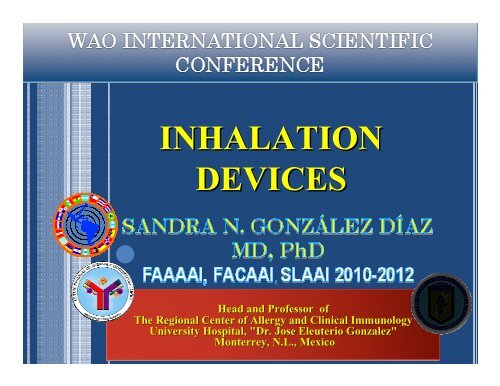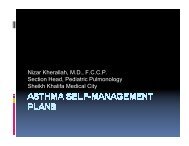Sandra González-DÃaz - World Allergy Organization
Sandra González-DÃaz - World Allergy Organization
Sandra González-DÃaz - World Allergy Organization
- No tags were found...
You also want an ePaper? Increase the reach of your titles
YUMPU automatically turns print PDFs into web optimized ePapers that Google loves.
INHALATIONDEVICESHead and Professor ofThe Regional Center of <strong>Allergy</strong> and Clinical ImmunologyUniversity Hospital, "Dr. Jose Eleuterio Gonzalez"Monterrey, N.L., Mexico
Director of the <strong>Allergy</strong> and Clinical Immunology Training Program,Centro Regional de Alergia e Inmunología Clínica, HospitalUniversitario de Monterrey, since 1990.Professor, Centro Regional de Alergia e Inmunología Clínica,Hospital Universitario de Monterrey, since 1990.Head of Centro Regional de Alergia e Inmunología Clínica,Hospital Universitario, Monterrey, N.L. since March 2000 – up todatePast President of the Mexican College of Clinical Immunology and<strong>Allergy</strong> (CMICA) -2005-2007Director of the Department of Funds Raising of the UniversityHospital, January 2007 - up to dateSchool of Medicine, U.A.N.L 1977- 1983. Monterrey, N.L.MexicoInternal Medicine Specialty, Universitary Hospital U.A.N.L.1986 - 1988, Monterrey, N.L.Fellowship Pediatric <strong>Allergy</strong> and Clinical Immunology, U.C.S.D.1987-1988, University of California, San Diego, USA<strong>Allergy</strong> and Clinical Immunology Specialty, UniversitaryHospital U.A.N.L. 1988 - 1990, Monterrey, N. L.Doctor´s Degree in <strong>Allergy</strong> and Clinical Immunology, UniversityHospital U.A.N.L. 1991 – 1997, Monterrey, N.L. President of UNASMA (International Asthma Foundation) 2007 –2011Director of the Institute of Clinical Immunology, Asthma and<strong>Allergy</strong> A.C. (NPO)President elect of the Latin-American Society of Asthma, <strong>Allergy</strong>and Clinical Immunology (SLAAI) 2010-2012Past President of the Mesoamerica Chapter of the Latin-AmericanSociety of Asthma, <strong>Allergy</strong> and Clinical Immunology (SLAAI),1997-1999
OBJETIVES Acquire an in-depth understanding of how the mostcommonly prescribed inhalation devices function Identify the device most appropriate to the individual’s needs Know correct and effective techniques for the mostcommonly available devices Teach and assess patient’s techniques effectively When necessary, refer to appropriate professionals from thehealth care team
RESPIRATORY THERAPY Inhaled administration of drugs in patients with respiratorydiseases ASTHMA CRUP COPD PNEUMONIA CYSTIC FIBROSISThis technique enables the drugs to actdirectly on the airwaysJ <strong>Allergy</strong> Clin Immunol 2009;124:S88-93
DRUGS AVAILABLES FORRESPIRATORY THEPAY Corticosteroids Bronchodilators Antiviral Antibiotics Antifungal MucolyticsInhaled corticosteroidsform an integral part ofasthmamanagement and arethe most effective longtermtherapyJennifer A.Vanden Burgt. <strong>Allergy</strong> Clin Immunol 2000;106:1209-26.
ADVANTAGES Best local effect of the product that optimizes the desiredeffects Lower doses Rapid onset of action Low systemic bioavailability Minimal side effect than drugs delivered orally orintravenouslyAmerican Association for Respiratory Care. Aerosol consensus statement. Respir Care1991;36:916–21
THE DEPOSIT OF THE PARTICLEDEPENDS: Particle size Speed inspiration Integrity of airway Proper technique
The effectiveness of an aerosol is largely dependenton how much of the medication actually reachesthe small peripheral airways of the lungsBurton G, Hodgkin JE, Ward J. Respiratory care: a guide to clinical practice. 3rd Ed.Philadelphia: JB Lippincott, 1992
987654321Deposit of particles by sizeParticles > 8 um are deposited in the oropharynx (90% absorbed)5-8 um are deposited in the large airways2-5 um are deposited in the tracheobronchial region1-2 um are deposited in the alveolar region
The physicalmechanisms governingthe movement anddeposition of aerosolparticles in the air are:- Impacted- Sedimentation- Diffusion
Particle depositionSpeed of inspiration: the idealflow is between 30 and 60 L /minHigh flow facilitates centralimpactionLow flow helps thesedimentation of particlesSedimentation0.5-5 micrasFlujo aereo bajoLa apnea post inhalacionfavorece la sedimentaciónImpacted>5 microsUpper airwayHigh flow rateDiffusion< 0 .5 micronsHigh-speedmovementshort haulare exhaled
INHALATION DEVICESSeveral different types ofinhalation devices areAvailable….but not all medicationsare available in eachdevice The choice of inhalation device will depend :Medication prescribedThe needs and capabilitiesof the individual patientHanania NA, et al.Medical personnel’s knowldege of and ability to use inhaling devices. Metered-dose inhalers, spacingchambers, and breath-actuated dry powder inhalers. Chest 1994;105:111–6.
DEFINITIONSAerosol• A suspension of small solid orliquid particles in a gasNebulizers• The devices are used to generateaerosols of liquid particles in a gascloudInhalers• Are the devices used to generateaerosols of solid particlesUSING INHALATION DEVICESDanielle Beaucage and Suzanne Nesbitt
INHALATION DEVICES Metered-dose inhlaler (MDIs)Conventional pressurized inhalerActivated by pressurized inhaler inspiration Dry-powder inhaler (DPIs)DoseMultidose NebulizersJetUltrasonicUSING INHALATION DEVICESDanielle Beaucage and Suzanne Nesbitt
METERED-DOSE DOSE INHLALER (MDIS) The most common device for inhaled drug delivery Consists of a pressurized canister and a chamber outfittedwith a mouthpiece and protective cover The canister contains a medication, a surfactant and/or asolvent, and a liquid propellant Chlorofluorocarbons (CFCs)Hydrofluoroalkanes (HFAs) The inhaler itself is designed to deliver exact doses ofmedicationUSING INHALATION DEVICESDanielle Beaucage and Suzanne Nesbitt
Diagram of the pressurized metered-dose inhalerAdapted with permission from GlaxoSmithKline, Canada
METERED-DOSE INHLALER(MDIS) A suspension MDI is onein which the drug isphysically ground downinto solid particles andthen the particles aresuspended in the liquidpropellant That is why suspensioninhalers need to be shaken A solution MDI means thatthe drug is actually dissolvedin the propellant / cosolventformulation The drug solution canproduce aerosolized dropletsin a size range when thepropellant evaporates, wouldresult in smaller, solid drugparticles
PROPELLLANTSChlorofluorocarbon(CFC) propellantsRecognition that CFC propellantsdeplete the ozone layer has led totheir productionbeing gradually phased out under theMontreal Protocolon Substances that Deplete theOzone LayerMontreal Protocol. The Montreal Protocol on substances that deplete the ozone layer. Final Act (Nairobi:UNEP, 1987). Federal Register 1994; 59:56276-98
PROPELLLANTSTo meet the need to find a replacement for CFCs inpressurized (“press and breathe”) metered-dose inhalers(pMDIs)Hydrofluoroalkane (HFA)Environmentally friendly propellantsrapidly replacing CFCs in pMDIs90´sMontreal Protocol. The Montreal Protocol on substances that deplete the ozone layer. Final Act(Nairobi: UNEP, 1987). Federal Register 1994; 59:56276-98
FEATURE DIFFERENCES BETWEEN CFCAND HFA MDISFeatureCFCHFAOutput speed High (150km/h) Much lower(3 time less)TemperatureCold sprayRelease lower doseReleases a warmsprayConsistent dose evenat -20CVolume High LowMass Medianaerodynamicdiameter3.5 -4.0um 1.0 -1.2um
HFA-BDPVanden Burgt. Efficacy and safety overview of a new inhaled corticosteroid, QVAR (hydrofluoroalkane beclomethasone extrafineinhalation aerosol), in asthma. J <strong>Allergy</strong> Clin Immunol 2000;106:1209-26
Lung deposition and particle size comparison ofsteroid inhalersLeach C et al. Particle size of inhaled corticosteroids: Does it matter? J <strong>Allergy</strong> Clin Immunol 2009 ;124:S88-93
HFA-BDP (ultrafine particle) provided greater improvement in FEV1 than CFC-BDP (large-particle inhaled steroid)*Used with permission from Busse et al.Leach C et al. Particle size of inhaled corticosteroids: Does it matter? J <strong>Allergy</strong> Clin Immunol 2009 ;124:S88-93
Dose-comparison calculation shows that it would take 2.6 times thedose of a large-particle inhaled steroid (CFC-BDP) to achieve the sameimprovement in FEV1 compared with an ultrafine-particle inhaled steroid (HFA-BDP)*Used with permission from Busse et al.30Leach C et al. Particle size of inhaled corticosteroids: Does it matter? J <strong>Allergy</strong> Clin Immunol 2009 ;124:S88-93
Pressurized metered-doseInhaler: illustration of techniqueRemove the cap Shake device Exhale to FRCBegin inhaling and actuatecanister onceInhale slowly until TLCClosed-mouth techniqueOpen-mouth techniqueHold breath for 10 secondsIf another dose is required,repeat steps
CARE AND MAINTENANCE OF THEPRESSURIZED METERED-DOSE INHALER Avoid temperature extremes Heat and cold The canister should be kept warm Cold temperatures will reduce the efficacy of a CFCdrivenpMDI Replace the inhaler’s protective cap between uses to avoidaspiration of foreign objects Dust, paperclips, coins, etcUSING INHALATION DEVICESDanielle Beaucage and Suzanne Nesbitt
The inhaler should be replaced when the medication hasexpired (see date printed on canister) or when the inhaler isnearing emptyEVALUATION OF CONTENTSEmpty1/41/23/4Full
PMDIAdventages: It has been proven that pMDIs are a reliable and effectivemethod of delivering inhaled medication When used properly, their efficacy is at least equal to that ofother inhalation devicesDisadventages : They are relatively complicated to use effectively Several studies have revealed that a large number of patientsare unable to master the techniqueGoodman DE, Isreal E, Rosenberg M, et al. The influence of age, diagnosis and gender on proper use of metereddoseinhalers. Am J Respir Crit Care Med 1994;150:1256–61Nimmo CJ, Chen DN, Matinusen SM, et al. Assessment of patient acceptance and inhalation technique of apressurized aerosol inhaler and two breath-actuated devices. Ann Pharmacother 1993;27: 922–7
METERED DOSE INHALERCOUNTER DOSEErgonomic grip builds a positive user experienceSportier look and feel appeals to younger usersStrong color use increases brand recognitionImproved hygiene with attached capTougher package for lots of abuse
BREATH ACTIVATED INHALERSInhalation device inspiroactivado dispenser bythe patientEASY BREATHAUTOHALERRequire low flows(18-30 L / min)Require no patient coordinationSALBUTAMOL-BudesonideBudesonide
RESPIMATSPIRIVA (TIOTROPIUM BROMIDE) Soft inhaler dispersionUse the mechanical strength of aspring instead of a propellant todeliver the drug dose
SPACING DEVICESSpacing devices were designed to overcome thedifficultiesexperienced when using a pMDISpacing devices are available invarying forms and sizesSpacing devices also improve thedeposition of medication in thelower airwaysAhrens R, Lux C, Bahl T, Han SH. Choosing the metered dose inhaler spacer or holding chamber that matches the patient’sneed: evidence that the specific drug being delivered is an important consideration. J <strong>Allergy</strong> Clin Immunol 1995;96:288–94.
SPACING DEVICESThe most efficient spacing devices have a holdingchamber and a one-way valve that opens duringinspiration and closes during expirationPreventing drug loss caused by poor coordination betweenactuation of the pMDI and inspirationDolovich M, Ruffin R, Corr D, Newhouse M. Clinical evaluation of a simple demand inhalation MDIaerosol delivery device. Chest 1983;84:36–41.
SPACING DEVICES ARE THEREFOREINDICATED AS FOLLOWS To overcome difficulties of patients who are unable to use pMDIs correctly(ie, because of coordination problems, physical or mental handicaps, etc) To reduce the risk of adverse effects with inhaled respiratory medications(especially when using high doses of inhaled corticosteroids) To decrease or eliminate coughing or arrested inspiration experienced bysome patients when using CFC-driven devices To administer inhaled medication during severe exacerbations asrecommended by the American Thoracic Society
EXAMPLES OF SPACING DEVICESAerochamber Plus Is a 145-mL rigid cylinder madeof polyester(Trudell Medical, London, ON) Adapter that makes it compatiblewith most pMDIs Is available with a mouthpieceor a mask Is an elliptical-shaped devicemade of rigid, transparent plastic Capacity of 750 MlVentaHaler®Designed to fit GlaxoSmithKlineproducts Not fit all pMDIs.
Diagram of the AeroChamber Plus VHC with adultmouthpiece(Adapted with permission from Trudell Medical International. London ON.)
AEROCHAMBERThey slow down and suspend smalldroplets of aerosolized medication forapproximately 1 to 2 secondsHis allows time for some of thepropellant surrounding theparticles of medication toevaporateThe inhaled aerosol is made up of agreater proportion of particles smallenough to reach the lower airwaysThe larger particles remain within thespacing device, thus significantlyreducing the deposition of medicationin the oropharynx and therebyreducing adverse effects
AEROCHAMBER PEDIATRICS Mask Least resistance in valves Lower volume ADULTSMask or mouthpieceMask sizeHigh Volume
AROCHAMBER Plastic chambers Electrostatic charge inside that makes the drug is retained inits walls Chambers of metallic material Avoid this problem by making better use of medication
SPACER WITH A MASKATTACHMENTAerochamber144mlone way valve3 modelBabyhaler260mltwo valvesunidirectionalGLAXOOptichamber350mlSound valveNebuchamber250mlTwo valvesunidirectionalASTRA
VENTAHALERSPACER WITH NOZZLEFisionair® (Fisons)Volume of 800 ccWay valveCompatible with allcartridgesVolumatic® (Glaxo) Volumeof 800 ccWay valveVentolín®, Serevent®Nebuhaler® (Astra)Volume 750ccWay valveAtrovent®, Berodual®,Pulmicort®
Spacing device: illustration of techniqueRemove caps from spacing deviceand pMDIShake inhaler and connect it tothe spacing device, keeping thepMDI uprightExhale to FRCInsert mouthpiecebetween lips7 a)Hold breath for 5 to 10secondsOr7b) Breath slowly in and outof the spacing device, 3 or 4times in a rowPlace the mask over the face,making sure that the mouth and Spray one dose of medicationInhale slowly until TLC* ( totalnose are coveredinto the chamberlung capacity )3 -5 sAdapted from the self-management program “Living well with COPD, Inhalation Technique Card, Spacing Device.”
The Aero Chamber PlusVHC with mask:Caregivers and teachers can observe the flexiblearea around themask compressing as the patient inhales.The AeroChamber PlusVHChas a special sound feature thatindicates when inspiration is toorapid, namely, a flow greater than45 L/min.
Children using a pressurized metered doseinhaler
STORAGE OF MEDICINESWITHOUT THE USE OF SPACER AND SPACER USE
CARE AND MAINTENANCE OF SPACINGDEVICESThe general procedure for cleaning most spacingdevices is as follows:Take the device apart following the manufacturer’s instructions.Spacing devices should be washed prior to their first use 1Soak the pieces in a basin of warm, soapy water Lavarlas con detergente, al menos cadaDo not rub the interior surfaces with sponges or brushes dos semanas, because dejandolas secar sin aclarar. this Este mismo procedimiento debe aplicarsewill cause the walls to be roughened and thus increase también the antes de amount comenzar a utilizar las ofcamaras nuevas.medication that will adhere to themAir-dry on a clean surface Si no fuera posible esperar impregnarse lacamara con 5-10 puffs del farmaco y dejarpasar unos minutos antes Cada 6 meses cambiar por una nuevaUSING INHALATION DEVICESDanielle Beaucage and Suzanne Nesbitt
DRY POWDER INHALERS (DPIS) Portable inspiratory flow-driven devices that deliver drypowder formulations of inhaled drugs to the lungsAlternative methods ofaerosol delivery that areeffective and easy to useare increasingly indemand
DRY POWDER INHALERS (DPIS)SINGLE -DOSE DEVICEMULTIPLE -DOSE DEVICES
DRY POWDER INHALERS (DPIS)Main factors that determine drug delivery to the lungs Inspiratory volume Flows generated by the patient Particles of 1-2 mm 30-60lts/min ideal inspiratory flowSome devices contain additives such aslactose or glucose to improve theperception of inhalationPedersen S. Inhalers and nebulizers: which to choose and why. Respir Med 1996;90:69–77.
DRY POWDER INHALERS (DPIS)ADVANTAGES AND DISADVANTAGESThey do not require coordination because the force of the patient’sinspiration activates the aerosolThey do not require propellants are not affected by the cold, and areenvironmentally friendlyAre small, lightweight and easy to handleSome devices may not be effective, however, for individuals withsevere airflow limitations or in acute situationsRequire a degree of manual dexterity and a basic understanding ofhow they workUSING INHALATION DEVICESDanielle Beaucage and Suzanne Nesbitt
DPI SINGLE -DOSE DEVICE•Drugs available:BudesonideCromolyn sodiumFormoterolIpratropium bromide.Capsules containing a single dose of drug and are perforated to power adeviceRequires high inspiratory flow, higher than the multiple dose devices
TURBUHALERBudesonideTerbutalineFormoterolCombinationSymbicort80-160-320mcgThe medication inthe Turbuhaler® isin the form of afine, additive freedry powderThe Turbuhaler® uses the force of inspiration to liftparticles that are deposited onto a dosing disc within thecontainer into the respiratory systemWith the exception offormoterol andabudesonidecombination which alsocontains lactose powder
Diagram of the Turbuhaler®Adapted with permission from AstraZeneca, Canada
Turbuhaler®:illustration oftechniqueHold the Turbuhaler® upright(mouthpiece up)Turn the colored handle in onedirection as far as possible. Then turnit back until you hear a clickExhale to FRC: breathe outnormallyInhale forcefully and deeplythrough mouthIf another dose is required,repeat stepsRemove plastic coverPut the protective cap back on
TURBUHALER®*Dolovich M, Vanzieleghem M, Hidingerk KG, Newhouse MT. Influence of inspiratory flow rate onthe response to terbutaline sulphate inhaled via the Turbuhaler. Am Rev Respir Dis 1988;137:A433.
TWISTHALERHOW TO USE TWISTHALERPreparing the Twisthaler® for UseHold the Twisthaler® straight upwith the pink portion on the bottomRemove the cap from the Twisthaler® by twisting off thecapAs you lift off the cap the dose counter on the pinkportion will count down by one. This action gets themedicine ready for you to inhale
• Hold the Twisthaler® away from your mouth and gently breathe out.•Seal your lips around the mouthpiece.• Inhale rapidly and deeply. Continue to take a full, deep breath.• Take the Twisthaler® out of your mouth. Hold your breath for 10 seconds.• Resume normal breathing. Do not breathe out into the Twisthaler.•Close the Twisthaler® by twisting on the cap.Ann Mullen, RN, MS, AE-C (June 2009)
Identifying When the Twisthaler®Is Empty1.The Twisthaler® has a dose counter on thepink base2. The dose counter will show the doses ofmedicine left. When the dose counter shows 01,there is one dose left3. When the Twisthaler® is empty the dosecounter will show 00 and the pink base will notturn. Start using a new Twisthaler. ®
ACCUHALERDISKUS®The Diskus ® is a new multidose DPI that contains 60doses of medication in a lactose-based carrierInhaled corticosteroidsShort- and long-acting β2 agonists andcombination therapy Fluticasone Salmeterol Salmeterol/fluticasoneSeretide 25/50-25/125-25/250
Diagram of the Diskus®Adapted with permission from GlaxoSmithKline, Canada
Diskus®: illustration of techniqueOpen the cover Slide the lever back Exhale to FRC, away fromthe Diskus®Close the Diskus®coverInhale a doseRemove the Diskus® from themouth and hold breath for 10secondsIf another dose isrequired, follow steps1 to 6
FEATURES TO CONSIDER The individual wrapping protects the powder from humidityand other environmental conditions The Diskus® provides a relatively consistent dose over awider range of flow rates than the other DPIsUSING INHALATION DEVICESDanielle Beaucage and Suzanne Nesbitt
FEATURES TO CONSIDER Inspiratory flow between 30 and 90 L/min ensuresdelivery of 90% of the dose The mouthpiece of the Diskus® should be wiped with aclean, dry cloth to prevent moisture from entering thesystem after each useUSING INHALATION DEVICESDanielle Beaucage and Suzanne Nesbitt
THE MAJOR DISADVANTAGES OF THEDISKHALER® It carries very few doses Requires the highest flows for adequate peripheral deposition Lactose, the drug carrier used in some DPIs, may be irritatingto the upper airways (mouth, throat), thus inducing cough,and Also has a taste that some patients find unpleasant This can, however, be reassuring to many because it signalsthat they have received their dose
NEBULIZERSNebulizers break down measured doses ofmedication in liquid form into a mist of smalldroplets, called an aerosolWet nebulization requires the following:An energy source such as a compressorCompressed air or oxygenA mask or a mouthpieceA nebulizer
NEBULIZERS- Ability to administer drugs at high doses and in combination- Supports different forms of oxygen therapy and assistedventilation- It provides humidification of the airways- Pneumatic nebulizers (Jet ®)- Ultrasonic NebulizerPedersen S. Inhalers and nebulizers: which to choose andwhy. Respir Med 1996;90:69–77.
Diagram of a nebulizer
Set up the compressorConnect the nebulizer to thecompressor outlet with thetubingTurn on the compressor andverify outputPrepare medication,place it in the nebulizercup, and connect themask or mouthpiecePlace mask over face or mouthpiece into mouth
PNEUMATIC NEBULIZERS (Jet ®)Optimal flow for most currently used nebulizersis between 6 and 10 L/minIt takes approximately 5 to 10 minutes toadminister 2.5 mL of solution at this flow rateBreathing should be slow and regular, with anoccasional deep breath
ULTRASONIC NEBULIZERSMore rapids and quietAn oscillator generates highfrequency vibrations that causesthe particles of medicine isgradually detached from the fluidmass and suspended in the air,forming the aerosol
CARE AND MAINTENANCE OFNEBULIZERSFollowing each use….The nebulizer cup should bedisassembled, rinsed, and air driedto prevent thecrystallization of the medicationMask or mouthpiece andnebulizer cupWashed in lukewarm, soapy water,rinsed thoroughly,and air-driedThe nebulizer should be turned on fora few minutes after cleaning to clearthe system of waterDisinfected using a solution of waterand vinegar
NEBULIZERSDISADVANTAGES No additional advantages over conventional systems The cost is higher High maintenance requirements Time consuming Dependent on outside power sources, electricity Noisy Less portableOnly 1 to 5% of the output from mostcompressed air nebulizers is delivered tothe lower branches of the bronchial tree
NEBULIZERSIt has been recommended …that pMDIs with spacers replace wet nebulizers forbronchodilator administration in the acute caresettingWill probably result in cost savingsConseil consultatif de pharmacologie GdQ. L’aérosolthérapie dans le traitement de l’asthme et des autresbronchopneumopathies obstructives. Québec: Ministère de la santé et des services sociaux,infomédicament,1995.
TREATMENT SUCCESS IS THERESULT OF A GOOD TEAM WORK
















